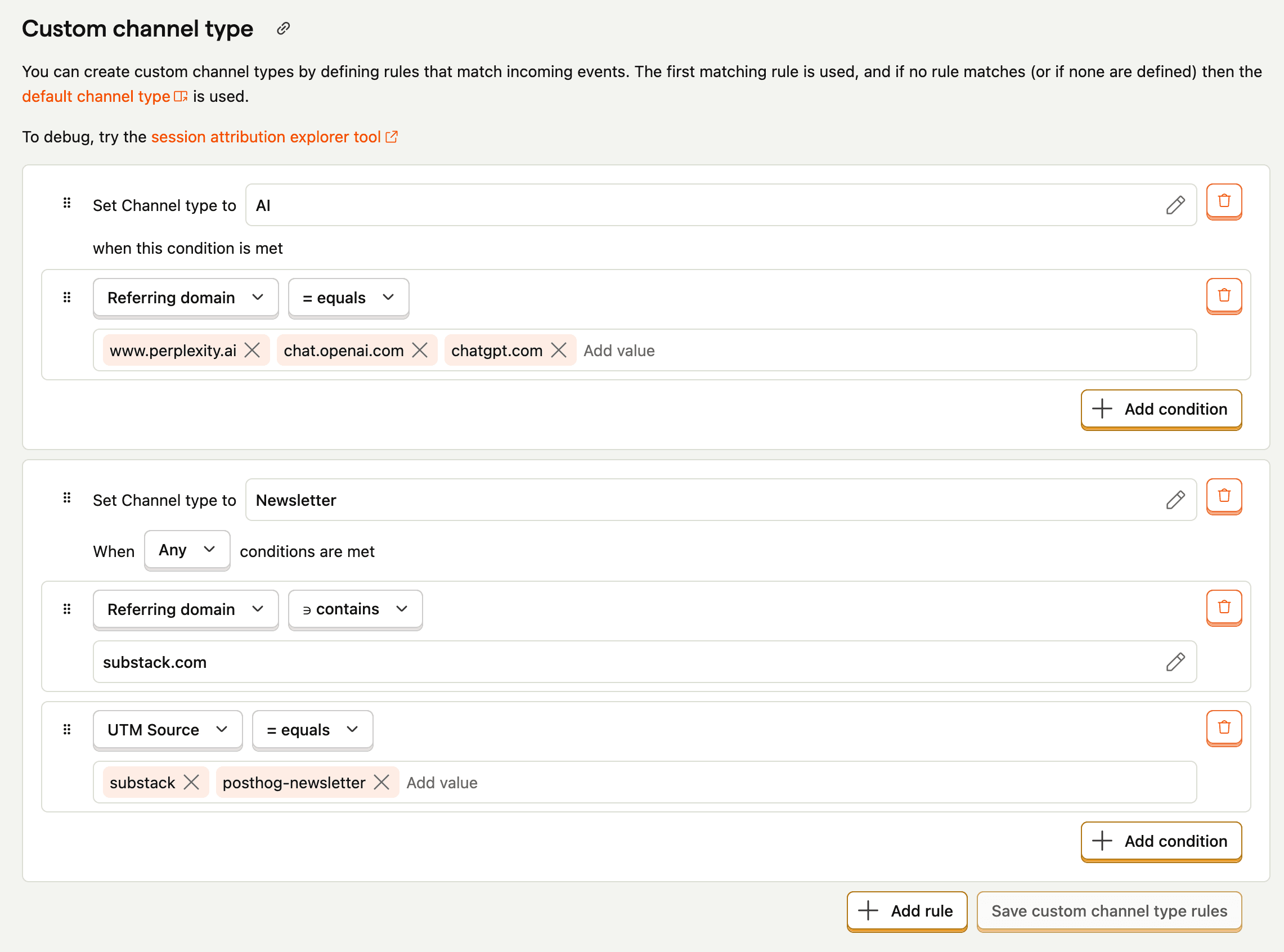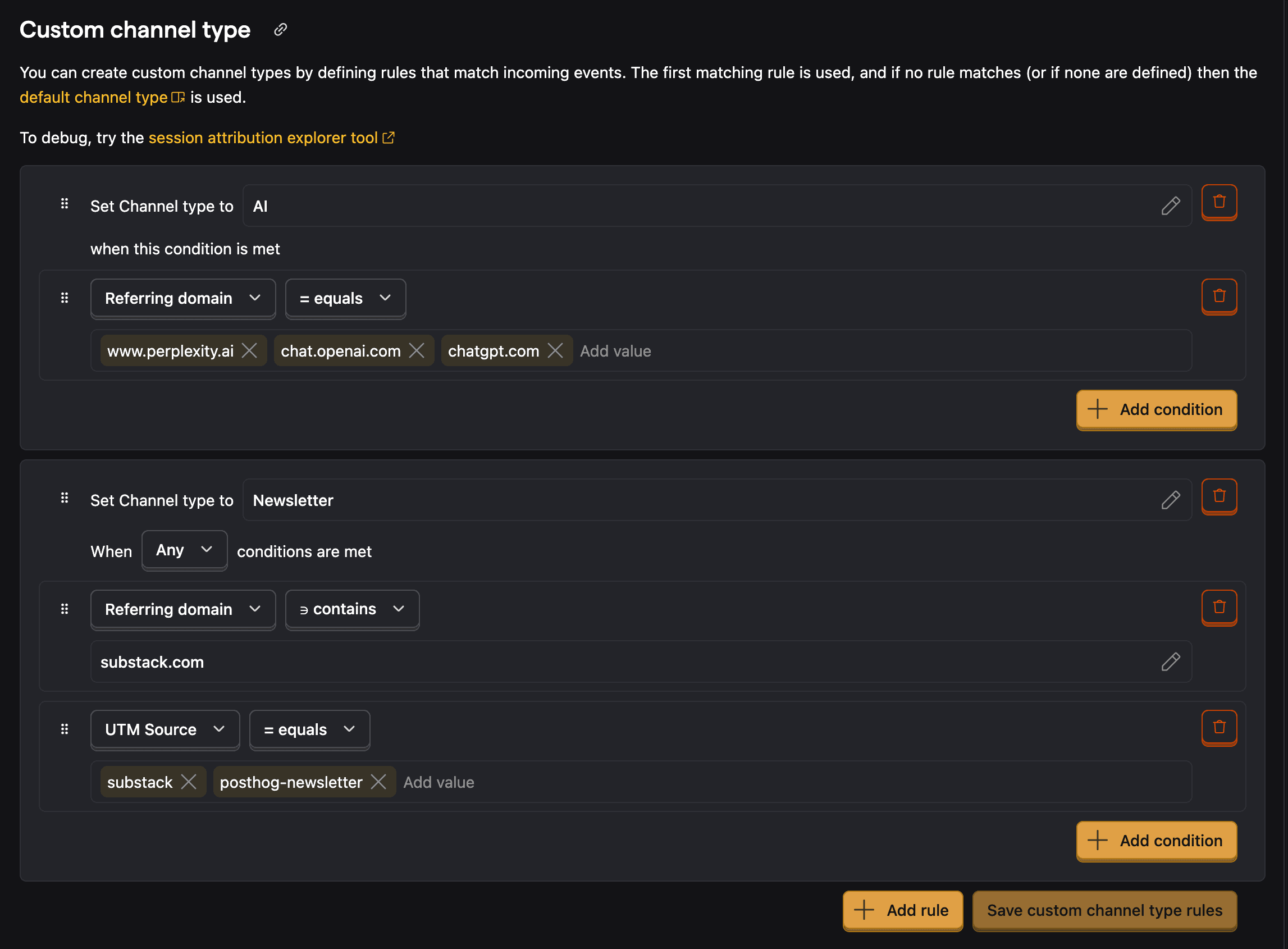Channel type
Contents
Channel type is the type of acquisition channel the user came from, for example:
| Channel Type | Description of where the user came from |
|---|---|
| Direct | User typed in the URL directly or used a saved link. |
| Paid Search | An ad from a search engine, e.g. Google, Bing, or Baidu. |
| Paid Social | An ad from a social media platform, e.g. Facebook, LinkedIn, or Twitter |
| Paid Video | An ad from a video platform, e.g. YouTube or Twitch. |
| Paid Shopping | An ad from a shopping platform, e.g. Amazon or eBay. |
| Paid Unknown | An ad from an unknown platform. |
| Cross-Network | A cross-network ad |
| Organic Search | A non-ad search result from a search engine, e.g. Google, Bing, or Baidu. |
| Organic Social | A non-ad link from a social media platform, e.g. Facebook, LinkedIn, or Twitter |
| Organic Video | A non-ad link from a video platform, e.g. YouTube or TikTok. |
| Organic Shopping | A non-ad link from a shopping platform, e.g. Amazon or eBay. |
| Affiliate | An affiliate link. |
| Referral | A referral link. |
| A link from an email. | |
| Display | A display ad, e.g. an ad on Google Display Network. |
| SMS | A link from an SMS. |
| Audio | An audio ad, e.g. a podcast ad. |
| Push | A push notification. |
| Unknown | A link from an unknown source. |
It is calculated using the referring domain, UTM tags, and advertising IDs that are present in the URL when the user first lands on your website.
Custom channel types


You can define your own custom channel types in your project settings under Web analytics. Your custom channel types will take priority over the default channel types.
Default channel type calculation
We maintain a set of default channel type rules that are designed to be a useful starting point for everyone, and many users won't need to add any custom channel type rules.
Traffic is considered "Paid" if any of the following are true:
utm_mediumis one ofcpc,cpm,cpv,cpa,ppcorretargetingutm_mediumstarts withpaid- Either
gclidorgad_sourceis present
We use a list of known values for referring_domain, utm_source, and utm_medium, which you can view in the source code.
These rules are applied in order, and the first one that matches is used to determine the channel type.
| Channel Type | Logic |
|---|---|
| Cross Network | utm_campaign equals cross-network |
| Paid Search | Traffic is paid, and utm_source matches our list of search sources (e.g. google, bing, duckduckgo) |
| Paid Social | Traffic is paid, and utm_source matches our list of social sources (e.g. facebook, linkedin, twitter) |
| Paid Video | Traffic is paid, and utm_source matches our list of video sources (e.g. youtube, twitch, disneyplus) |
| Paid Shopping | Traffic is paid, and utm_source matches our list of shopping sources (e.g. amazon, etsy, ebay) |
| Paid Search | Traffic is paid, and referring_domain matches our list of search sources (e.g. google.com, bing.com, duckduckgo.com) |
| Paid Social | Traffic is paid, and referring_domain matches our list of social sources (e.g. facebook.com, linkedin.com, twitter.com) |
| Paid Video | Traffic is paid, and referring_domain matches our list of video sources (e.g. youtube.com, twitch.tv, disneyplus.com) |
| Paid Shopping | Traffic is paid, and referring_domain matches our list of shopping sources (e.g. amazon.com, etsy.com, ebay.co.uk) |
| Paid Shopping | Traffic is paid, and utm_campaign matches the regular expression ^(.*(([^a-df-z]|^)shop|shopping).*)$ |
| Paid Social | Traffic is paid, and utm_medium matches our list of social mediums (e.g. sm, social-media, social-network) |
| Paid Video | Traffic is paid, and utm_medium matches our list of video mediums (e.g. video) |
| Display | Traffic is paid, and utm_medium matches our list of display mediums (e.g. display, interstitial, banner) |
| Paid Search | Traffic is paid, and gad_source equals 1 |
| Paid Video | Traffic is paid, and utm_campaign matches the regular expression ^(.*video.*)$ |
| Paid Unknown | Traffic is paid |
| Direct | Referring domain is the special value $direct, and utm_medium is not set, and utm_source is either empty or equal to direct or (direct) |
| Organic Search | utm_source matches our list of search sources (e.g. google, bing, duckduckgo) |
| Organic Social | utm_source matches our list of social sources (e.g. facebook, linkedin, twitter) |
| Organic Video | utm_source matches our list of video sources (e.g. youtube, twitch, disneyplus) |
| Organic Shopping | utm_source matches our list of shopping sources (e.g. amazon, etsy, ebay) |
utm_source matches our list of email sources (e.g. email, e_mail, e-mail) | |
| SMS | utm_source matches our list of SMS sources (e.g. sms) |
| Push | utm_source matches our list of SMS sources (e.g. firebase) |
| Organic Search | referring_domain matches our list of search sources (e.g. google.com, bing.com, duckduckgo.com) |
| Organic Social | referring_domain matches our list of social sources (e.g. facebook.com, linkedin.com, twitter.com) |
| Organic Video | referring_domain matches our list of video sources (e.g. youtube.com, twitch.tv, disneyplus.com) |
| Organic Shopping | referring_domain matches our list of shopping sources (e.g. amazon.com, etsy.com, ebay.co.uk) |
| Organic Shopping | utm_campaign matches the regular expression ^(.*(([^a-df-z]|^)shop|shopping).*)$ |
| Organic Social | utm_medium matches our list of social mediums (e.g. sm, social-media, social-network) |
| Organic Video | utm_medium matches our list of video mediums (e.g. video) |
| Affiliate | utm_medium matches our list of affiliate mediums (e.g. affiliate) |
| Referral | utm_medium matches our list of referral mediums (e.g. referral, link, app) |
utm_medium matches our list of email mediums (e.g. email, e_mail, e-mail) | |
| Display | utm_medium matches our list of display mediums (e.g. display, cpm, interstitial, banner) |
| Audio | utm_medium matches our list of referral mediums (e.g. audio) |
| Push | utm_medium matches our list of referral mediums (e.g. push, notification, mobile) |
| Organic Video | utm_campaign matches the regular expression ^(.*video.*)$ |
| Push | utm_medium ends with push |
| Unknown | No previous rule matched |
You can read our list of known sources in the source code.








